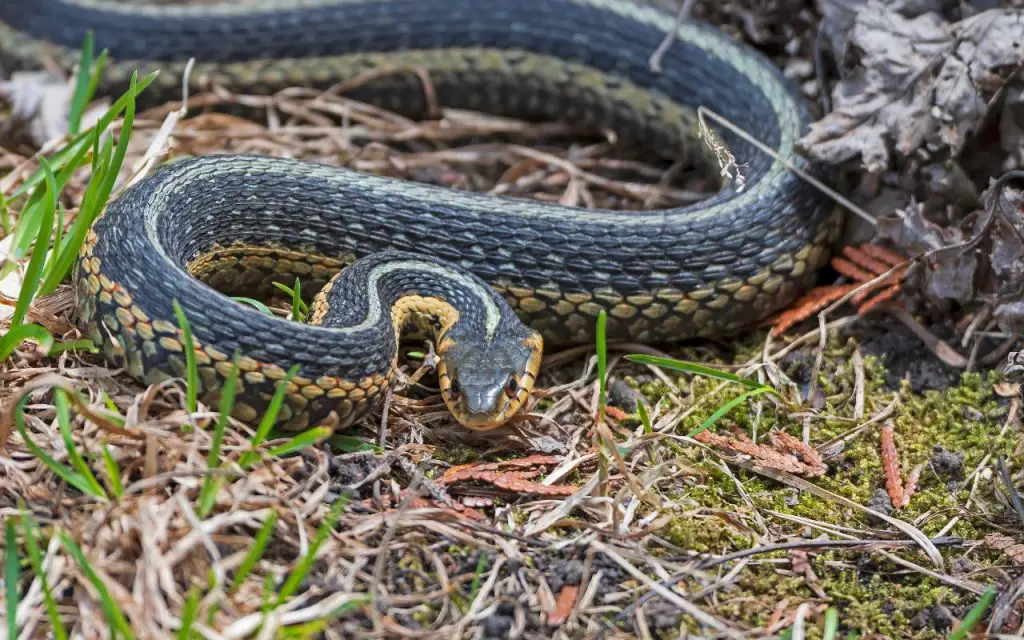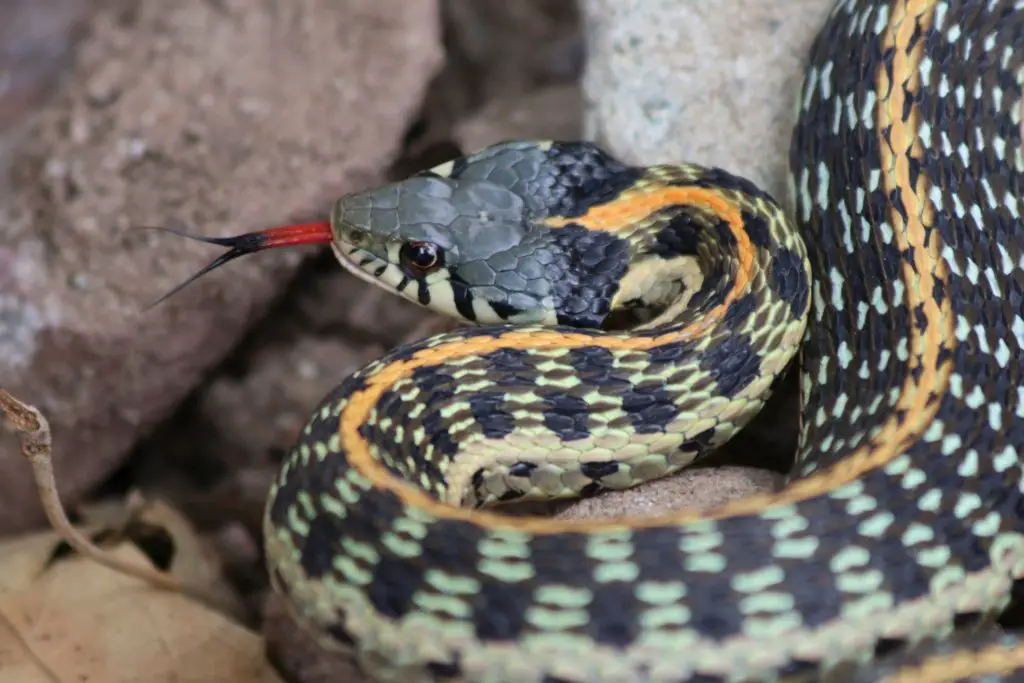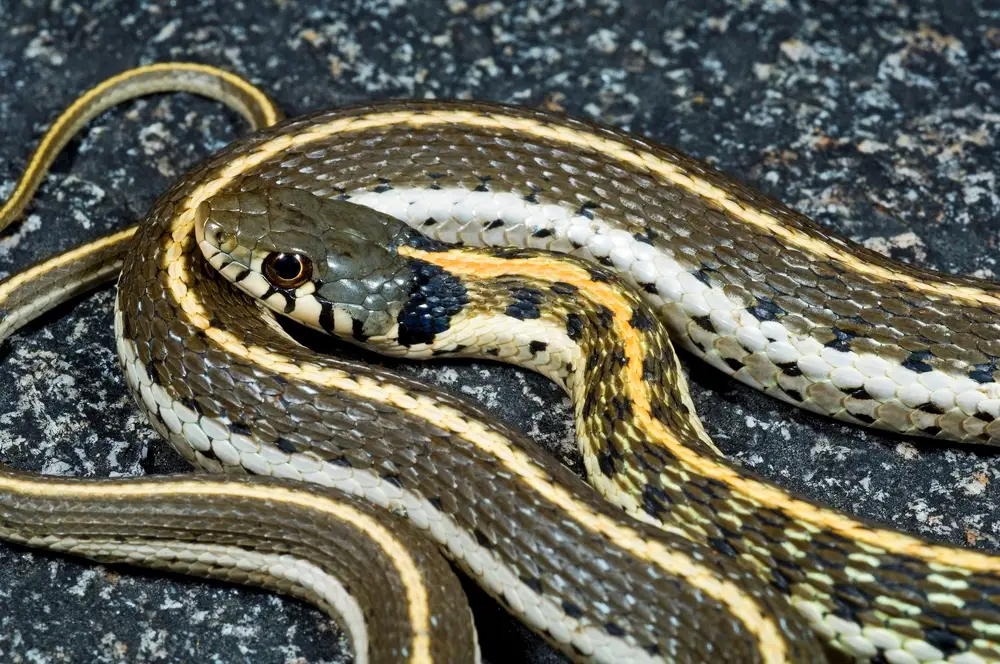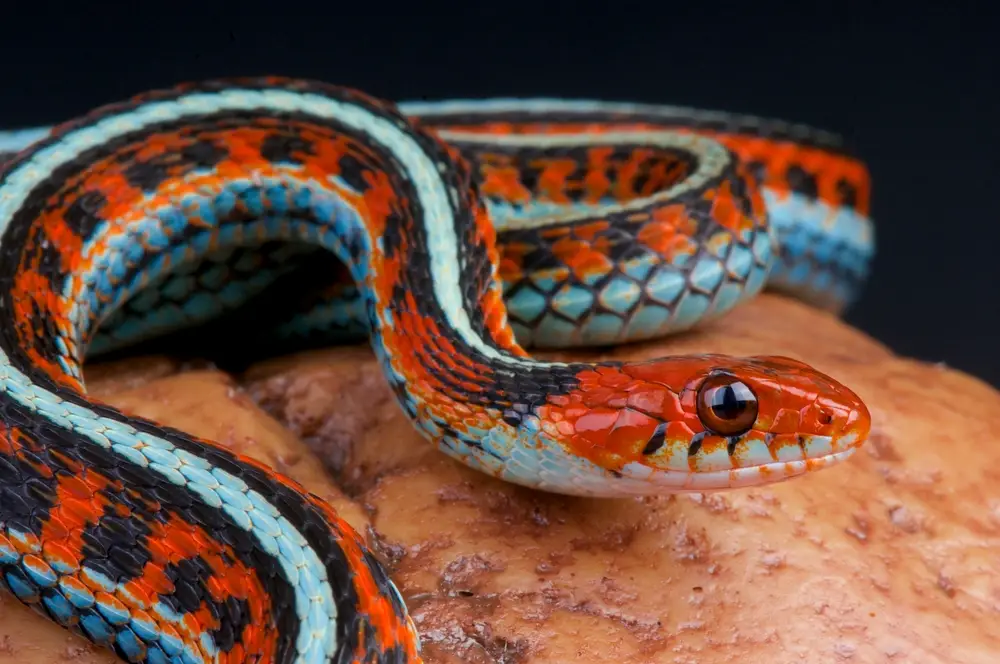Is it safe to pick up a Garter Snake you find in your yard? In most cases, yes. But it might be unpleasant for you. Let’s find out why…
It is safe to pick up a Garter Snake, as they do not possess a potent venom, big teeth, or powerful bite. More importantly, it’s important to remember that Garter Snakes play a vital role in the ecosystems of most of North America. They’re also great pest control for gardeners.
About Garter Snakes
Garter Snakes are small, Natricine snakes in the Thamnophis genus. Admittedly this doesn’t sound like a particularly enlightening description, but it actually tells you a lot about them.
Natricine snakes are those in the Natricinae subfamily, and tend to be some of the most widespread, successful species across much of the Northern Hemisphere.
They aren’t successful because they’re tough, though. For the most part they are in fact small, timid snakes that get between 24 and 36 inches long.
Instead, their success comes from the fact that they eat a lot amphibians, arthopods, and worms, and that they’re highly adaptable.
In much of North America, and particularly the Eastern US, you probably will have a Garter Snake take up residence on your property at some point.
Ponds, hedges, areas of long grass, or even a piles of old boards all make homes that these snakes love.
So given how likely it is you’ll meet one, I’ve written this article to tell you how to handle them safely, and let you know why you really should consider keeping them around.

Benefits of Garter Snakes
One thing I noticed when keeping and observing Garter Snakes is that really aren’t picky about food. I’ve seen them eat everything from toads to maggots.
Though the adults do have a real fondness for toads, I often find that the young ones eat a range of invertebrates. Unlike larger snakes, they also tend to eat more often, probably due to the smaller size of this type of prey.
If you’re a keen gardener, this makes a resident Garter Snake perfect pest control. That’s just one reason I would recommend keeping them around rather than relocating them.
In addition to being good helpers for us, this bug-eating lifestyle makes them beneficial to the environment as a whole. In areas where they are very numerous, they also occasionally raid rodent nests and help control the local mouse population.
Potential Dangers of Garter Snakes
In recent years, there’s been a few studies on Garter Snake toxicity. The findings have shown that they have very small amounts of weak toxins in their saliva.
It’s a real stretch, and takes some mental gymnastics, but you can technically define this as venom, and declare Garter Snakes to be venomous.
Having been bitten by probably over a hundred over the years, I’m going to go ahead and say I don’t consider them venomous.
In fact, there’s only a handful of cases where people have had adverse reactions to their bites. One example was the case of a boy who let a Wandering Garter Snake bite him, then pressed its teeth into his finger for a full 5 minutes. The result was some blisters and localised swelling.
Obviously, I’m going to guess that none of you reading will be doing a similar experiment. It does serve to prove that getting a bad reaction from a Garter Snake bite is actually quite hard, though!
So what is the real danger of picking up a Garter Snake? They musk on you. Musking is a defence mechanism where a snake voids the contents of its cloaca on you. The cloaca being the excretory opening at the base of the tail.
Garter Snakes possess powerful scent glands within their cloaca that make a foul smell to deter predators.
When you pick up a Garter and it musks on you, you’re going to stink for a while. It won’t hurt you physically, but you’re definitely going to wish you hadn’t.

Understanding Garter Snake Behavior
There’s three reasons you might want to understand Garter Snake behavior:
- You want them to help control pests on your property
- You want them to leave your propery
- You’re a reptile enthusiast, and want to find them in the wild
In my experience, Garter Snakes are extremely fond of the border areas of habitat types. What I mean by this is the edge of a field rather than the middle, or the edge of a wooded patch rather than the center.
The reason for this is that they use border areas as convenient basking places, and use the nearby cover to seek shelter if predators approach.
For this reason, the most common places to encounter Garter Snakes are:
- The edges of ponds and slow-moving rivers. Both Garter Snakes and their cousins, the Ribbon Snakes, love water
- Clearings in forests, or the edge of a forested area
- Along fences
- Along ditches
- Places where long grass meets short grass
If you want to see them, check these places within local habitat first, or try to recreate them on your property. On the other hand, if you don’t want them on your property, then these are features to eliminate. Easier said than done!
Behavior of pet Garter Snakes
In my experience, Garter Snakes make great pets. The only thing that makes them a little more complicated to keep than other popular species is that they need UVB lighting.
Wild Garter Snakes spend a lot of time basking, and naturally pick up a lot of their vitamin D3 through UV exposure.
When it comes to handling pet Garter Snakes, they all get tame incredibly quickly. I’ve literally had ones become tame within a couple of days. That said, their temperament varies with age.
Generally speaking, you’ll find that the younger they are, the more squirmy they are, making them awkward to handle. As they age, they gradually get more relaxed and slow-moving, which allows you to handle them as you would a Corn Snake, for example.
The main takeaway here is don’t handle very small Garter Snakes standing up, or above any space or crack they could crawl into. That is how accidents happen, and how pets disappear!

How to safely pick Up a Garter Snake
So you’ve found a Garter Snake somewhere it shouldn’t be. In your garage, pool, or in a road perhaps. In this case, there’s two ways to safely handle it (without getting musked!).
- Herd it into a bucket or trash can. You put a container on its side, in front of the Garter Snake’s face, and gentle herd it in with a broom, or other soft-ended implement. Don’t use anything hard, or you risk injuring it. Once it goes in, simply turn the container upright, and so long as it’s taller than the snake’s total length, it has no way of escaping. You can now release it in the nearest patch of habitat that it was crawling towards, or call your local wildlife authority for help.
- Use gloves. These should be heavy-duty gloves like you’d use for construction work. Ideally they should be the kind that are long enough to cover most of your forearms. Wearing these, no amount of biting or musking will do anything to you in the slightest (Garter teeth are way too small to get through them). You simply grasp the snake with both hands and place it into a container like we’ve discussed above. There is no need to squeeze it hard, or grab it behind the neck like the snake-beaters on TV do!
Is it safe to pick up a Garter Snake? Conclusion…
In most cases, it is safe to pick up a Garter Snake, the main concern is the terrible smell of their musk. Myself, I love Garter Snakes, and used to spend hours observing them every summer as a kid – I still can’t stand the smell of them, though!
If you have to handle a Garter Snake, use one of the methods we’ve outlined in this article. Alternatively, if you’re wondering about how tame a pet Garter Snake would be, keep in mind that most them will quickly becoming accustomed to handle and stop musking completely.

FAQ relating to picking up Garter Snakes
Can you handle a garter snake?
You can handle garter snakes, but be aware of two things. First, wild snakes may bite or musk on you. The bites of even the largest Garter Snakes are harmless, feeling like tiny scratches, but the musk smell is strong and lasts for hours. Second, pet Garters get more calm with age, be careful of dropping juvenile snakes which tend to be wriggly.
Will garter snakes bite if you pick them up?
Some Garter Snakes will bite and others won’t. In the Common Garter Snake (Thamnophis sirtalis), for example, I always found it to be about a 50/50 split between those that would bite and those that didn’t even try.
How do you pick up a garter snake with your hands?
Always pick up a Garter Snake with two hands, supporting its whole body. Never pick it up by the neck or the tail, both ways could injury it. If you’re wearing gloves, you can simply pick one up by grasping as much of its body as possible, and applying just enough pressure to stop it wriggling free.

